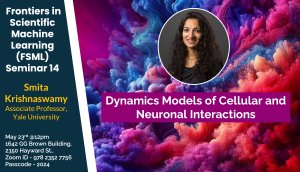Presented By: Frontiers in Scientific Machine Learning (FSML)
Frontiers in Scientific Machine Learning Seminar 14: Inferring and Characterizing Cellular and Neural Dynamics with Geometric and Topological Deep Learning
Smita Krishnaswamy

This is a hybrid event. Attendees can join on-campus or virtually via Zoom.
Zoom ID - 978 2352 7756, Passcode - (last year in format YYYY)
Abstract:
In the last decade there has been a data revolution in biology with the advent of high-throughput high dimensional data modalities such as single-cell RNA-sequencing, fMRI data, molecular structure data and other modalities. A key issue in these data types is that they provide static snapshots of highly dynamic biological entities. In this talk I will cover our work inferring and characterizing cellular and neural dynamics during various processes. First, I will cover how to infer cell state dynamics during differentiation and disease with a neural ODE framework called MIOflow that is regularized with data geometric and manifold priors. Then I will discuss RITINI, our recent graph ODE network which allows us to learn gene regulation that underlies cellular dynamics, and potentially find new targets for treatments of disease. I will showcase applications of these in triple negative breast cancer and human embryonic stem cell differentiation. Once these dynamics are available, I will showcase tools to quantify and classify these dynamics based on graph signal processing and topological data analysis. This will involve our learnable geometric scattering transform to capture spatial signal patterns, as well as persistence homology and other tools to quantify time-varying patterns. Applications to characterization of brain activity data will be presented.
Bio:
Smita Krishnaswamy is an Associate Professor in the departments of Computer Science (SEAS) and Genetics (YSM). She is part of the programs in Applied Mathematics, Computational Biology & Bioinformatics and Interdisciplinary Neuroscience. She is also affiliated with the Yale Institute for the foundations of data science, Wu-Tsai Institute, Yale Cancer Center. Her lab works on fundamental deep learning and machine learning developments for representing and learning from big data. Her techniques incorporate mathematical priors from graph spectral theory, manifold learning, signal processing, and topology into machine learning and deep learning frameworks, in order to denoise and model the underlying systems faithfully for predictive insight. Currently her methods are being widely used for data denoising, visualization, generative modeling, dynamics. modeling, comparative analysis and domain transfer in datasets arising from stem cell biology, cancer, immunology and structural biology (among others).
Prior to joining Yale, she completed her postdoctoral training at Columbia University in the systems biology department where she focused on learning computational models of cellular signaling from single-cell mass cytometry data. She obtained her Ph.D. from EECS department at University of Michigan where her research focused on algorithms for automated synthesis and probabilistic verification of nanoscale logic circuits. Following her time in Michigan, she spent 2 years at IBM's TJ Watson Research Center as a researcher in the systems division where she worked on automated bug finding and error correction in logic. Her work over the years has won several awards including the NSF CAREER Award, Sloan Faculty Fellowship, and Blavatnik fund for Innovation.
Zoom ID - 978 2352 7756, Passcode - (last year in format YYYY)
Abstract:
In the last decade there has been a data revolution in biology with the advent of high-throughput high dimensional data modalities such as single-cell RNA-sequencing, fMRI data, molecular structure data and other modalities. A key issue in these data types is that they provide static snapshots of highly dynamic biological entities. In this talk I will cover our work inferring and characterizing cellular and neural dynamics during various processes. First, I will cover how to infer cell state dynamics during differentiation and disease with a neural ODE framework called MIOflow that is regularized with data geometric and manifold priors. Then I will discuss RITINI, our recent graph ODE network which allows us to learn gene regulation that underlies cellular dynamics, and potentially find new targets for treatments of disease. I will showcase applications of these in triple negative breast cancer and human embryonic stem cell differentiation. Once these dynamics are available, I will showcase tools to quantify and classify these dynamics based on graph signal processing and topological data analysis. This will involve our learnable geometric scattering transform to capture spatial signal patterns, as well as persistence homology and other tools to quantify time-varying patterns. Applications to characterization of brain activity data will be presented.
Bio:
Smita Krishnaswamy is an Associate Professor in the departments of Computer Science (SEAS) and Genetics (YSM). She is part of the programs in Applied Mathematics, Computational Biology & Bioinformatics and Interdisciplinary Neuroscience. She is also affiliated with the Yale Institute for the foundations of data science, Wu-Tsai Institute, Yale Cancer Center. Her lab works on fundamental deep learning and machine learning developments for representing and learning from big data. Her techniques incorporate mathematical priors from graph spectral theory, manifold learning, signal processing, and topology into machine learning and deep learning frameworks, in order to denoise and model the underlying systems faithfully for predictive insight. Currently her methods are being widely used for data denoising, visualization, generative modeling, dynamics. modeling, comparative analysis and domain transfer in datasets arising from stem cell biology, cancer, immunology and structural biology (among others).
Prior to joining Yale, she completed her postdoctoral training at Columbia University in the systems biology department where she focused on learning computational models of cellular signaling from single-cell mass cytometry data. She obtained her Ph.D. from EECS department at University of Michigan where her research focused on algorithms for automated synthesis and probabilistic verification of nanoscale logic circuits. Following her time in Michigan, she spent 2 years at IBM's TJ Watson Research Center as a researcher in the systems division where she worked on automated bug finding and error correction in logic. Her work over the years has won several awards including the NSF CAREER Award, Sloan Faculty Fellowship, and Blavatnik fund for Innovation.